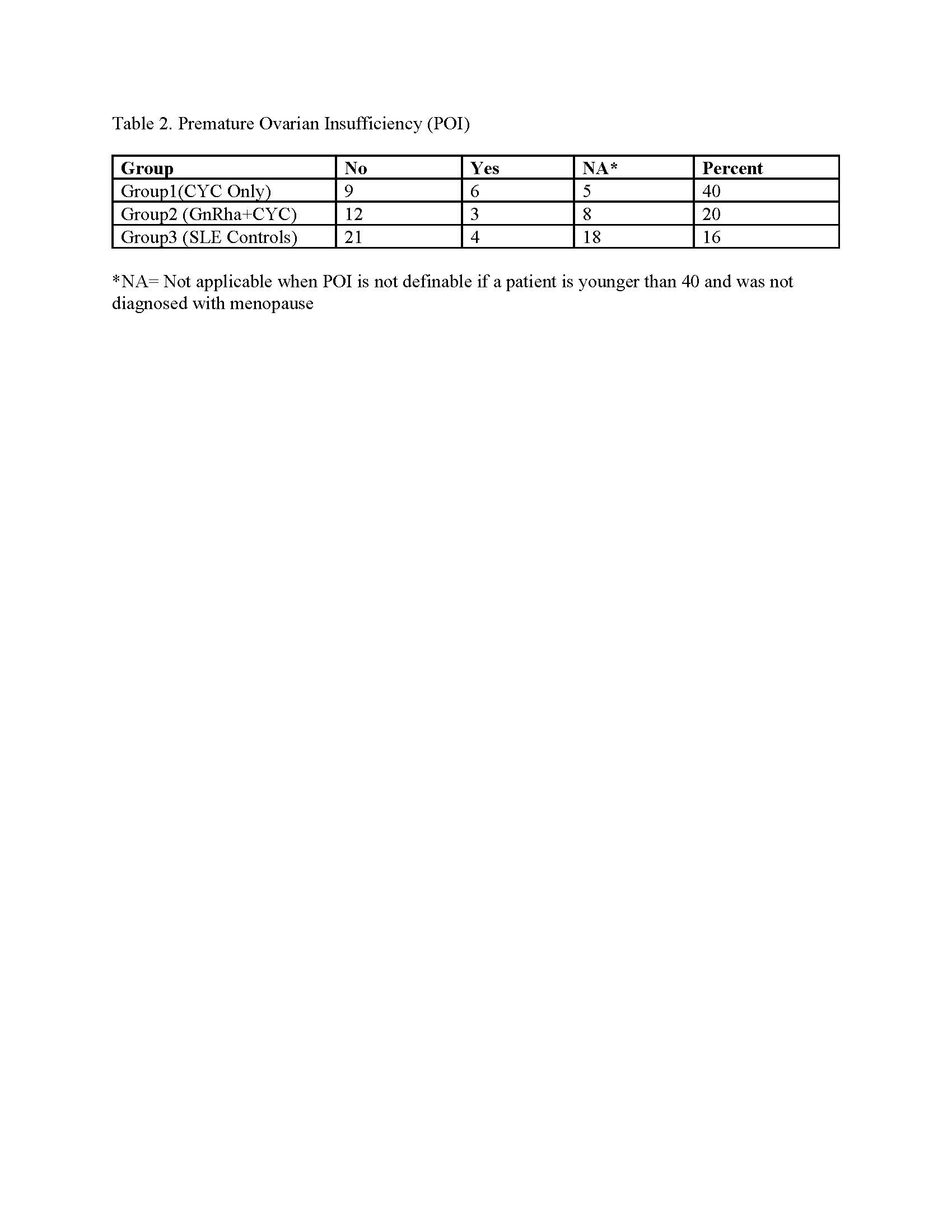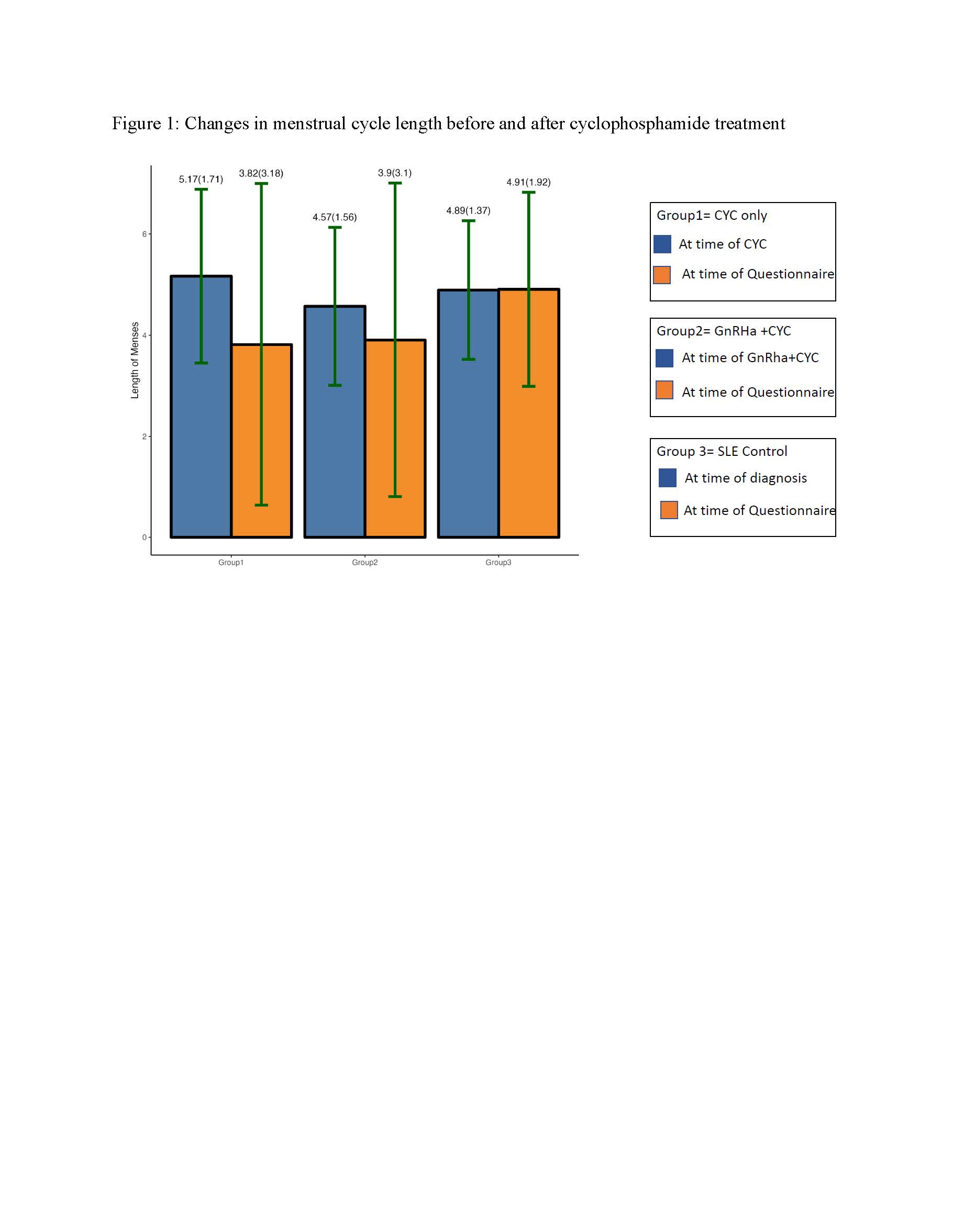Session Information
Session Type: Poster Session B
Session Time: 9:00AM-11:00AM
Background/Purpose: SLE patients with life-threatening lupus manifestations are often treated with cyclophosphamide (CYC), which has known cytotoxic effects on ovarian reserve. Co-administration of Gonadotropin-releasing hormone agonist (GnRHa) is suggested to protect ovaries from the cytotoxic effects of CYC but there is lack of data to support its use. We administered a questionnaire evaluating ovarian function of a cohort of SLE patients who either received CYC alone or GnRHa+CYC.
Methods: The study was approved by the National Institutes of Health, Institutional Review Board. Female SLE patients < 40 years old at the time of IV CYC treatment were included in this study. Review of medical records resulted in: CYC only (n=20) =group 1, GnRHa+CYC (n=30) =group 2. These patients were age/gender matched with SLE patients not treated with CYC (n=50) =group 3. Data about demographics, disease activity, damage accrual, and cumulative CYC dose were collected. Data from questionnaires assessed regularity, duration of menstrual cycles, and pregnancies, before and after CYC. Premature ovarian insufficiency (POI)was defined as menopause prior to 40 years. Fisher’s exact test and one-way ANOVA were performed in R (version 4.2.2) for categorial and continuous variables, respectively.
Results: There were no significant differences in age, disease activity, damage accrual, mean cumulative CYC dose, and duration of follow-up (Table 1).However, age at diagnosis and consequently age at time of CYC infusion was higher in group 1 compared to group 2. There were more Hispanic patients in group 2 and 3. 88/100 patients completed the questionnaire (Group 1=20, Group 2=23, Group 3=43).Post-CYC, 40% of group 1 patients reported POI compared to 20% of group 2 and 16% group 3, calculated as total of all POI defined (Table 2). Length of menses was decreased by 1.4 days (p=0.083) in group 1 compared to 0.7 days (p=0.122) in group 2 (Figure 1). There was no statistical significance seen between regularity of menses between group 1 and 2 pre and post CYC treatment. Similar numbers of pregnancies and live birth were reported by all groups. Data concerning adverse events related to GnRHa were not collected.
Conclusion: Our study suggests that co-administration of GnRHa with CYC protects the ovary from its cytotoxic effects. Incidence of POI, and other markers of ovarian dysfunction such as length of menstrual cycle were significantly higher when CYC was administered alone. Larger, prospective studies are needed to establish role of GnRHa in preserving ovarian function in patients with SLE.
To cite this abstract in AMA style:
Chu J, Abid D, Manna Z, Paul S, Ochoa I, Wu Y, Goyal S, Naqvi S, Hooda L, Hasni S. Efficacy of Gonadotropin-releasing Hormone Agonist (GnRHa) in Ovarian Preservation in Women with Systemic Lupus Erythematosus (SLE) Receiving Cyclophosphamide (CYC) [abstract]. Arthritis Rheumatol. 2023; 75 (suppl 9). https://acrabstracts.org/abstract/efficacy-of-gonadotropin-releasing-hormone-agonist-gnrha-in-ovarian-preservation-in-women-with-systemic-lupus-erythematosus-sle-receiving-cyclophosphamide-cyc/. Accessed .« Back to ACR Convergence 2023
ACR Meeting Abstracts - https://acrabstracts.org/abstract/efficacy-of-gonadotropin-releasing-hormone-agonist-gnrha-in-ovarian-preservation-in-women-with-systemic-lupus-erythematosus-sle-receiving-cyclophosphamide-cyc/



